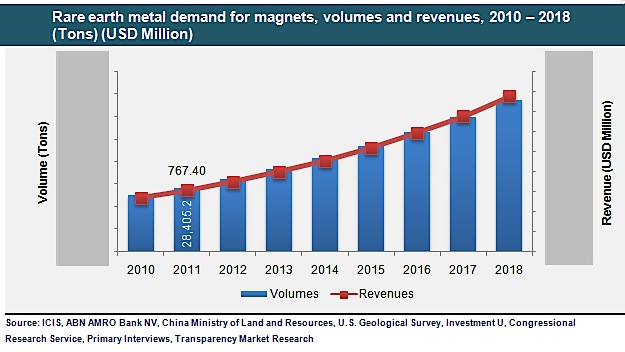 The rare earths industry is about to experience a clean-versus-dirty battle until now only seen among fuel producers, as a Chilean company is stepping up efforts to grab some of that market in a much greener way than China, the world’s top producer of such elements.
The rare earths industry is about to experience a clean-versus-dirty battle until now only seen among fuel producers, as a Chilean company is stepping up efforts to grab some of that market in a much greener way than China, the world’s top producer of such elements.
Mineria Activa’s project aims to develop the market for rare earths in the copper producing country, based on a recent survey that showed there are major concentrations of elements such as neodymium and dysprosium, south of capital Santiago. What’s even better: those deposits are quite similar to the ones found in southern China.
The firm’s project, named Biolantánidos, will dig out the clay, put it through a tank-leaching process with biodegradable chemicals and return it cleaned to the ground, replanting pine and eucalyptus trees. In China, operators pump ammonium sulfate into the ground and wait for the chemical to seep out with the minerals.
“It may be laborious,” Arturo Albornoz, who heads the project told Bloomberg, but he believes that soon firms such as thyssenkrupp AG, Apple Inc. and Tomahawk cruise missile maker Raytheon Co. will choose to pay a bit more for supplies extracted in a way that doesn’t destroy the planet. “It’s our big bet on green mining,” he added.
Currently China continues to dominate the rare earth market, producing about 90% of the elements that are vital in the creation of a big variety of electronic technologies including lithium car batteries, solar panels, wind turbines, flat-screen television, compact fluorescent light bulbs, petroleum-to-gasoline catalytic cracking, and military defence components such as missile guidance systems.
Crumbling monopoly
The Asian giant did not always enjoy a virtual monopoly on REE production. The majority of the 17 rare earth elements were sourced from placer deposits in India and Brazil in the late 1940s.
During the 1950s, South Africa mined the majority of the world’s REEs from large veins of rare earth-bearing monazite.
From the 1960s to 1980s, rare earths were supplied mainly from the US, mostly from the massive Mountain Pass mine in California, which was eventually mothballed in 2002.
China then took over the industry completely, producing more than 95% of the world’s REEs centred in Inner Mongolia and also becoming the top consumer ahead of Japan and South Korea.
Worries about Beijing’s monopoly of production sent prices for all rare earths into the stratosphere from 2008 onwards with some REEs going up in price twenty-fold or more.
 China applied export quotas and raised export tariffs on rare earths in 2010 to protect natural resources, ending the export restrictions in 2015 and scrapping the tariffs from May 1, in line with a ruling from the WTO.
China applied export quotas and raised export tariffs on rare earths in 2010 to protect natural resources, ending the export restrictions in 2015 and scrapping the tariffs from May 1, in line with a ruling from the WTO.
Despite the quotas and tariffs removal, rare earth companies, especially smaller ones, will continue suffering this year, analysts agree, as prices for some of the elements have dropped significantly in recent years.
The challenging environment doesn’t seem to bother the Chilean firm, which expects that its project, still in a pilot stage, will start producing rare earths by the end of 2016.
3 Comments
Anopheles
The assumption that some large companies will buy REE from “clean” mines is taking a tremendous risk.
They may buy a small percentage of clean REE, but it will depend on the price. If there is a big price difference (or any price difference) then they will buy from the cheaper supplier.
I know that TK already manufactures a LOT of their material handling equipment for the mining industry in China. It’s manufactured to German standards.
Companies these days are very good at giving the appearance of being socially and environmentally conscious, but things are a wee bit different after you scratch the surface. I will add that this doesn’t occur from the top levels of the companies, but stem from decisions made at the middle/regional management. These are the people who are desperately competing against other divisions to show how well their particular division performs (profits). So they don’t always toe the same corporate line as the top levels of the company.
Jean-CLaude Bünzli
This is good news but I guess it will take at leat 5 years before the resource is going into full production.
Regarding the influence of price on buying decision, it depends on the product . For instance a smart phone contains a total of less than .3 g of 9 different RE; this is worth less than 1 US $, so even if the price is 20-30% more I think there is no problem.
On the other hand, a wind turbine contains 400-600 kg Nd/Pr/Dy and for this, price will matter a lot!
Ashrafe
Fantastic News! For those who are keen to join over 200 delegates, including eminent speakers and moderators,
high-level dignitaries, Ministries, CEOs, VPs, and industry professionals at
the 13 edition of the Argus Rare Earths 2015 Conference, please visit http://www.argusmedia.com/RareEarths